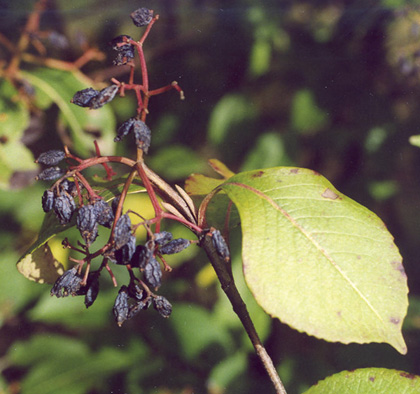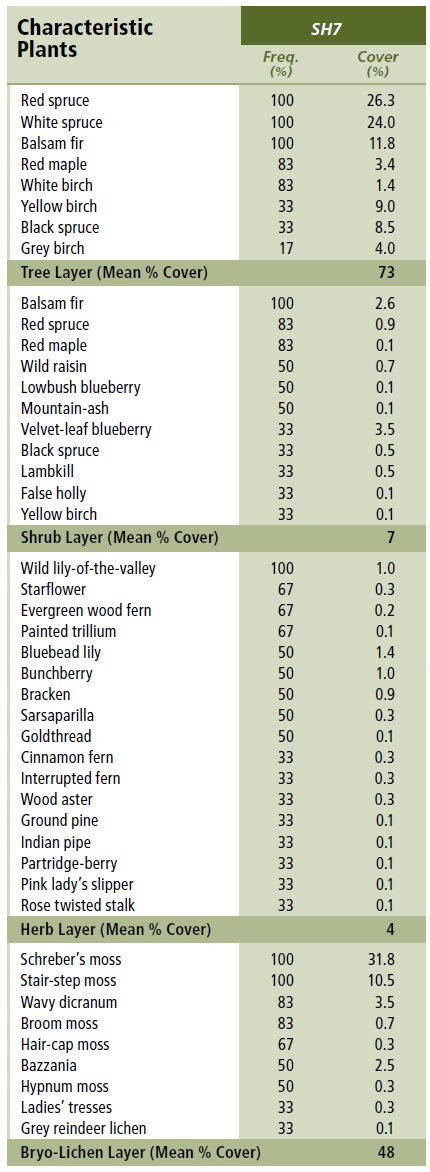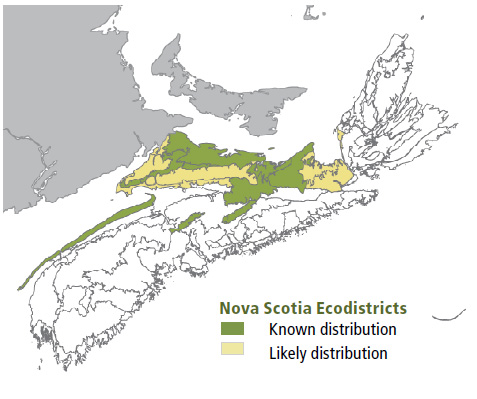
Forest Vegetation types - SH7
SH7 — White spruce – Red spruce / Blueberry / Schreber's moss
Picea glauca – Picea rubens / Vaccinium spp. / Pleurozium schreberi
 |
Skinners Cove, Pictou County |
Concept: This mid-successional Vegetation Type (VT) has an overstory of white and red spruce with lesser balsam fir. The absence of white spruce in the understory suggests this VT will advance to increased red spruce and balsam fir coverage over time. SH7 usually follows stand-replacing disturbance events such as fire, windthrow or harvesting.
Vegetation: White spruce, red spruce and balsam fir are the main overstory trees, but stands may also contain white, yellow or grey birch – the presence of which indicates recent disturbance events. Hybrid (red/black) spruce can also be found on poorer sites. The shrub layer is dominated by regenerating softwoods, primarily red spruce and balsam fir. Other shrubs include mountain-ash, wild raisin and lowbush blueberry. The herb layer is comprised of typical woodland flora (e.g. wild lily-of-the-valley and bunchberry), but species richness and coverage are both low. The bryophyte layer also has low species richness, but Schreber's moss and stair-step moss coverage is high in some stands.
Environmental Setting: SH7 is mainly associated with fresh, nutrient medium soils of glacial origin. These soils are generally medium to coarse textured and are sometimes shallow to bedrock. This VT is most common in the Northumberland Lowlands and Cumberland Hills ecodistricts. This VT is uncommon in both Prince Edward Island and New Brunswick.
Successional Dynamics: SH7 is a predominantly even-aged, mid-successional VT dominated by white and red spruce. This VT usually follows stand-replacing disturbances from fire, windthrow or harvesting. Possible early successional VTs include IH3 (Large-tooth aspen / Christmas fern – New York fern), IH4 (Trembling aspen / Wild raisin / Bunchberry), IH5 (Trembling aspen – White ash / Beaked hazelnut / Christmas fern) and IH6 (White birch – Red maple / Sarsaparilla – Bracken). In the absence of stand-level disturbance, white spruce and balsam fir in this VT will eventually succumb to agents (such as bark beetle, tussock moth and disease) allowing red spruce and sometimes yellow birch to increase in dominance. Possible later successional VTs include SH5 (Red spruce – Balsam fir / Schreber's moss), SH6 (Red spruce – Balsam fir / Stair-step moss – Sphagnum) and MW1 (Red spruce – Yellow birch / Evergreen wood fern). Hemlock is unlikely to be a major component of later successional stages.
Ecological Features: This is a large patch closed canopy forest with limited distribution in northern Nova Scotia. Red spruce is very shade-tolerant and white spruce slightly less tolerant in the understory. Good seed crops in red spruce start at age 35-45, and the species does not regenerate well before age 50. Mature forests may provide habitat for red squirrels and flying squirrels. Spruce seeds provide food for finches, crossbills and kinglets. South facing slopes may provide winter cover for deer. These forests may support abundant mycorrhizal mushrooms including chanterelles and boletes. No plant or lichen species of conservation concern were found in available plot data.
 |
| Wild raisin |
Distinguishing Features: White spruce growing with red spruce and lesser balsam fir is diagnostic of this softwood forest usually found in northern Nova Scotia. Schreber's moss and stair-step moss coverage is high in many stands.
| Slope Position: | Upper5 Level3 Crest2 |
Surface Stoniness: |
(Non - Slightly)7(Moderately)3 |
Bedrock Outcrop: |
(Non-rocky)8 (Slightly - Moderately)2 |
Elevation Range: |
30 - 228m |
Slope Gradient: |
Level5 Gentle5 |
Aspect: |
North2 East2 South2 West2 None2 |
Exposure: |
Moderate5 Mod. exposed3 Mod. sheltered2 |
Microtopography: |
Moderately3 Slightly3 Strongly3 |
Drainage: |
Well7 Moderately well2 Imperfect1 |
Soil Type: |
ST23 ST63 ST2-L2 ST152 |
Parent Material: |
Glacial till8 Till/Bedrock2 |
Rooting Depth (cm): |
(<30)3 (30-45)5 (>45)2 |
Duff Thickness (cm): |
(0-5)2 (6-10)3 (11-20)5 |

